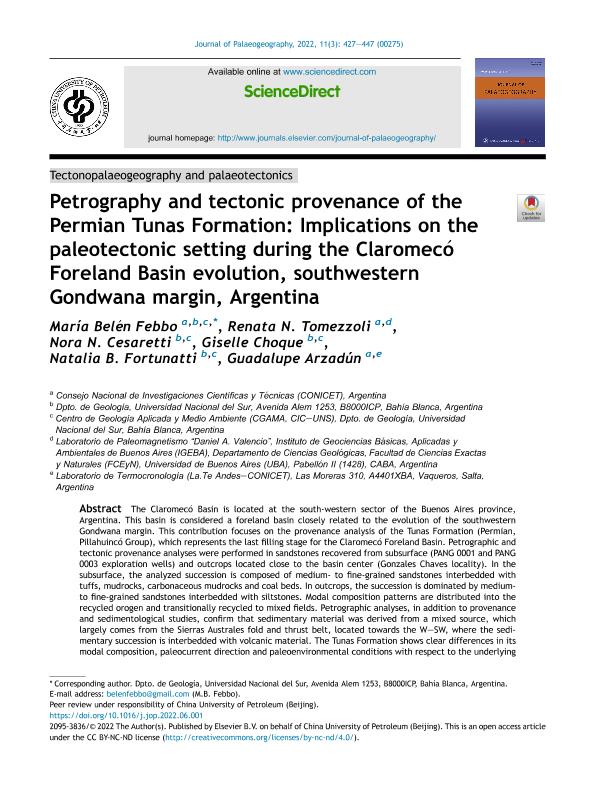Artículo
Petrography and tectonic provenance of the Permian Tunas Formation: Implications on the paleotectonic setting during the Claromecó Foreland Basin evolution, southwestern Gondwana margin, Argentina
Febbo, María Belén ; Tomezzoli, Renata Nela
; Tomezzoli, Renata Nela ; Cesaretti, Nora Noemi; Choque, Giselle
; Cesaretti, Nora Noemi; Choque, Giselle ; Fortunatti, Natalia Beatriz
; Fortunatti, Natalia Beatriz ; Arzadún, Guadalupe
; Arzadún, Guadalupe
 ; Tomezzoli, Renata Nela
; Tomezzoli, Renata Nela ; Cesaretti, Nora Noemi; Choque, Giselle
; Cesaretti, Nora Noemi; Choque, Giselle ; Fortunatti, Natalia Beatriz
; Fortunatti, Natalia Beatriz ; Arzadún, Guadalupe
; Arzadún, Guadalupe
Fecha de publicación:
06/2022
Editorial:
Elsevier
Revista:
Journal of Palaeogeography
ISSN:
2524-4507
Idioma:
Inglés
Tipo de recurso:
Artículo publicado
Clasificación temática:
Resumen
The Claromecó Basin is located at the south-western sector of the Buenos Aires province, Argentina. This basin is considered a foreland basin closely related to the evolution of the southwestern Gondwana margin. This contribution focuses on the provenance analysis of the Tunas Formation (Permian, Pillahuincó Group), which represents the last filling stage for the Claromecó Foreland Basin. Petrographic and tectonic provenance analyses were performed in sandstones recovered from subsurface (PANG 0001 and PANG 0003 exploration wells) and outcrops located close to the basin center (Gonzales Chaves locality). In the subsurface, the analyzed succession is composed of medium- to fine-grained sandstones interbedded with tuffs, mudrocks, carbonaceous mudrocks and coal beds. In outcrops, the succession is dominated by medium-to fine-grained sandstones interbedded with siltstones. Modal composition patterns are distributed into the recycled orogen and transitionally recycled to mixed fields. Petrographic analyses, in addition to provenance and sedimentological studies, confirm that sedimentary material was derived from a mixed source, which largely comes from the Sierras Australes fold and thrust belt, located towards the W–SW, where the sedimentary succession is interbedded with volcanic material. The Tunas Formation shows clear differences in its modal composition, paleocurrent direction and paleoenvironmental conditions with respect to the underlying units of the Pillahuincó Group (Sauce Grande, Piedra Azul and Bonete formations). Source areas changed from cratonic to mixed fold belt/arc-derived material, suggesting variations in the Claromecó Basin configuration during the Late Paleozoic. Changes in the paleotectonic scenario during the deposition of the Tunas Formation have been interpreted as a consequence of a compressive post-collisional deformation event, the product of adjustment, accommodation and translation of terrains towards the equator during the Permian–Triassic to form Pangea.
Archivos asociados
Licencia
Identificadores
Colecciones
Articulos(IGEBA)
Articulos de INSTITUTO DE GEOCIENCIAS BASICAS, APLICADAS Y AMBIENTALES DE BS. AS
Articulos de INSTITUTO DE GEOCIENCIAS BASICAS, APLICADAS Y AMBIENTALES DE BS. AS
Articulos(SEDE CENTRAL)
Articulos de SEDE CENTRAL
Articulos de SEDE CENTRAL
Citación
Febbo, María Belén; Tomezzoli, Renata Nela; Cesaretti, Nora Noemi; Choque, Giselle; Fortunatti, Natalia Beatriz; et al.; Petrography and tectonic provenance of the Permian Tunas Formation: Implications on the paleotectonic setting during the Claromecó Foreland Basin evolution, southwestern Gondwana margin, Argentina; Elsevier; Journal of Palaeogeography; 11; 3; 6-2022; 427-447
Compartir
Altmétricas



